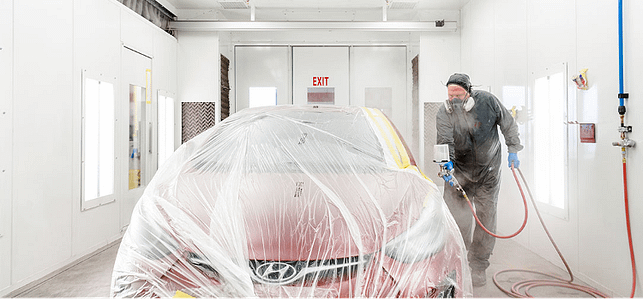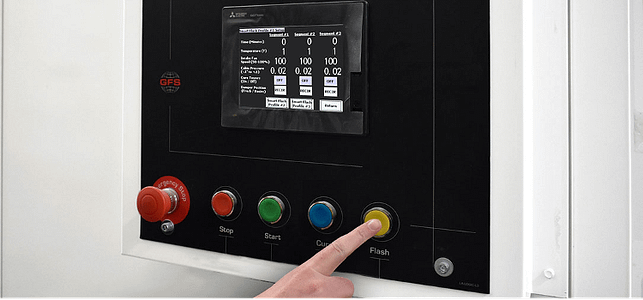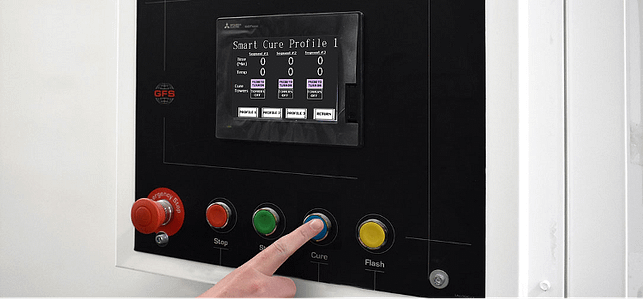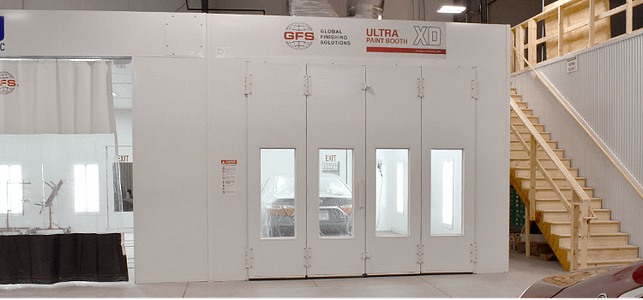
For collision repair centers with significant volume, having a heated paint booth is essential to avoid backlogs and keep up with production demands. Heated paint booths have key modes that make operating the spray booth a breeze and ensure efficient, quality paint finishes. Let’s break down each mode:

The first mode that is used when operating a paint booth is spray mode, during which paint is sprayed onto the vehicle. Spray mode ensures the paint booth has the correct air pressure and temperature to produce your desired results.
To activate spray mode in a GFS paint booth, the operator turns on the power to the paint booth, then presses the Spray button on the control panel. The spray cycle runs as follows:

Flash mode is initiated on the control panel or by using an optional puff switch inside the booth. During flash, the booth temperature increases, allowing solvents to be rapidly released from the paint before the next coat or the final cure.
The temperature and duration of flash mode depends on the type of paint and application method used. The time setting is determined by the painter, often based on the recommendation of the paint company’s safety data sheet (SDS).
Depending on the spray booth configuration, the transition to flash mode may include a purge cycle to evacuate contaminated air from the paint booth. If the paint booth has a GFS AdvanceCure System, it comes on at this time. If the burner is selected on, you can use an elevated flash temperature.

Cure mode enables the curing of the paint that was sprayed onto the vehicle. During the cure cycle, the paint booth will reach and hold a preset temperature — up to 200 degrees Fahrenheit. For operator safety, no one should enter the booth during cure mode.
The operator starts the cure cycle at the control panel. This activates a preset timer. The cure time counter starts when the paint booth reaches the preset temperature.
The cure mode operating cycle on a GFS paint booth is as follows:

The cooling phase is the time required to cool down the heating unit and the interior of the paint booth following cure mode. This phase starts automatically upon completion of the cure period.
If the temperature setting is too low, it becomes impossible for the outside air to cool the paint booth to the preset temperature. In this case, a preset timer interrupts the cooling, even if the preset temperature has not been reached.
Cool down is similar to spray mode in that the dampers automatically position themselves to draw 100 percent fresh air from the outside. Power to the paint booth should never be turned off during cool down. Doing so will stop the blower assembly, preventing the proper cooling of the combustion chamber, which could overheat and become damaged.
Knowing how each of the four modes in a heated paint booth functions can help body shops maximize efficiency and promote quality paint finishes, while keeping up with production demands.
One of the best ways to highlight your business is through a story that you can share across your online platforms. It humanizes your business and shows that your business can make a meaningful impact. Your testimonial would be used as a project profile on the GFS Booth Blog and can be shared on your website and/or social media channels.
Complete this form and we’ll be in touch to showcase your company.

Shop a variety of GFS aftermarket products, including booth protection products and mobile accelerated curing units. And enjoy the convenience of fast and free ground shipping throughout the contiguous United States.

Located at GFS’ headquarters in Osseo, Wisconsin, the Center for Excellence is an innovative facility featuring an automotive refinish training center, as well as a separate space dedicated to technical product training.

GFS is continuously searching for talented, ambitious individuals to join our team. We aim to provide our employees with every opportunity to make an impact on the company and find their niche along the way — weather in a production, field services or an office position.